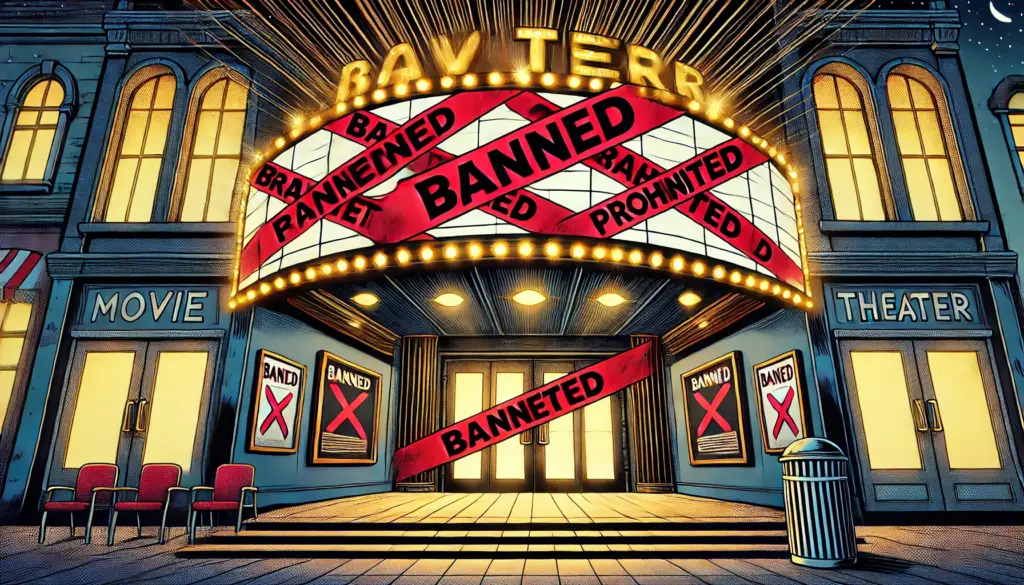
These Japanese films came dangerously close to being banned—either due to their political messaging, explicit content, or controversial portrayal of history. Each represents a cultural battle over what can and cannot be shown on screen.
1. Night and Fog in Japan – 日本の夜と霧 (1960)
Director: Nagisa Ōshima
📝 Synopsis: A wedding between two leftist activists becomes a stage for reliving political betrayals and regrets tied to the 1950 and 1960 Anpo protests.
🔥 Controversy: The film’s stark critique of both the Japanese Communist Party and student leaders was explosive. Just days after the assassination of socialist leader Asanuma, Shochiku pulled the film, citing “timing concerns”—a move seen as studio censorship under political pressure.
💥 Public Reaction: Oshima resigned from Shochiku in protest, calling it “ideological murder.” The event sparked one of Japan’s earliest postwar debates on artistic freedom and political expression.
2. Battle Royale – バトル・ロワイアル (2000)
Director: Kinji Fukasaku
📝 Synopsis: A dystopian government forces schoolchildren to kill each other on a remote island as a way to control rising juvenile delinquency.
🔥 Controversy: The film depicted brutal teen-on-teen murder, triggering uproar from lawmakers and educators. Critics claimed it could “inspire school violence” or desensitize youth to brutality.
💥 Public Reaction: Politicians tried to block its release. It received an R-15 rating but became a box office hit. Internationally, it was blacklisted in the U.S. and Germany for years. Today, it’s considered a cult classic and precursor to The Hunger Games.
3. Midori – 少女椿 (1992, remastered 2016)
Director: Hiroshi Harada
📝 Synopsis: A young girl joins a grotesque traveling circus and descends into abuse and humiliation in a surreal, adult fairytale.
🔥 Controversy: The visuals were so extreme that film labs refused to process it. In 1999, authorities seized copies under obscenity laws. Critics accused the film of child exploitation and pornography, despite its artistic intent.
💥 Public Reaction: It was long screened underground. Mainstream release was blocked until 2013. Even then, it was limited to niche venues and festivals, symbolizing the blurred line between art and indecency.
4. Fighting Soldiers – 戦ふ兵隊 (1938)
Director: Fumio Kamei
📝 Synopsis: A documentary capturing the human toll and emotional fatigue of Japanese soldiers in China, without glorifying them.
🔥 Controversy: The military government deemed it anti-national. It showed “too much reality,” undermining Japan’s militarist narrative. Kamei was stripped of his filmmaking license and briefly detained.
💥 Public Reaction: At the time, the film was quickly erased from public memory. In retrospect, it’s viewed as one of Japan’s first authentic anti-war films and is studied for its bravery under authoritarian censorship.
5. In the Realm of the Senses – 愛のコリーダ (1976)
Director: Nagisa Ōshima
📝 Synopsis: A true story of obsessive erotic love between a servant and her employer in 1930s Japan, culminating in sexual asphyxiation and murder.
🔥 Controversy: The film included unsimulated sex scenes, prompting a massive obscenity trial. The Japanese version was heavily cut, while a full version was only screened in France.
💥 Public Reaction: Ōshima was prosecuted but won in court, famously arguing: “Obscenity is not a crime unless someone is harmed.” The film became a symbol of the fight for sexual expression and censorship resistance.
🔎 Summary Table
| Film Title (JP) | Main Controversy Point | Outcome |
|---|---|---|
| 日本の夜と霧 (Night and Fog) | Political critique of both left and right factions | Pulled after 4 days |
| バトル・ロワイアル (Battle Royale) | Graphic teen violence; fears of social impact | Restricted rating, global delays |
| 少女椿 (Midori) | Obscenity, child abuse imagery | Banned, revived after 20 years |
| 戦ふ兵隊 (Fighting Soldiers) | Anti-war message; unpatriotic portrayal | License revoked, director punished |
| 愛のコリーダ (In the Realm…) | Real sex on screen; obscenity lawsuit | Edited version only allowed |
🎯 My Perspective
Censorship doesn’t just silence film—it stifles reflection. These movies weren’t pulled because they were bad, but because they reflected truths Japan wasn’t ready to face—about war, sex, politics, or youth. And yet, most eventually returned, celebrated as icons. They prove that real art always comes back.



















































